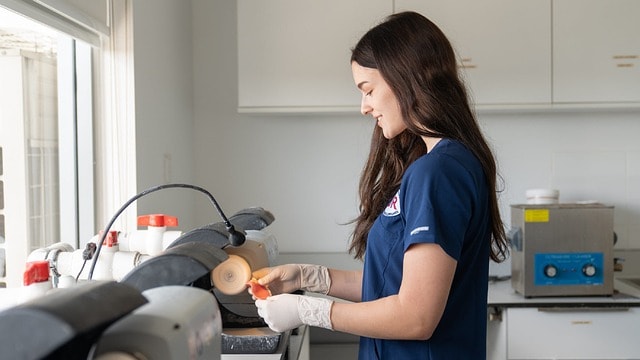Table of Contents

The Most Common Communication Problems Between Dental Laboratories and Dental Practices
The cooperation between dental practices and dental laboratories is a crucial component of successful patient care. Both parties—the dentist and the dental technician—must work as a team to deliver high-quality dental restorations on time. Efficient communication ensures that all relevant patient case information is exchanged accurately and promptly. If this process breaks down, delays, additional costs, and frustration can follow. Nothing is more frustrating for a dental practice than having to cancel an appointment through no fault of their own—such as when a laboratory fails to complete work on time.
Such incidents highlight why seamless coordination between practices and labs is essential—not only for patient satisfaction and treatment quality but also for the financial success of both partners.
Common Communication Issues
Despite the importance of coordination, communication problems between dental practices and laboratories are common. These issues can arise from various factors, including personnel challenges and technical limitations. However, they often lead to the same consequences: extra workload due to follow-up questions, delays in completing work, or misunderstandings regarding execution requirements. The following sections outline the key problem areas.
Insufficient Training of Dental Assistants and Its Impact
In many dental practices, dental assistants handle most of the communication with the laboratory. This includes filling out lab orders, making phone calls, and sending documents. If these assistants are not adequately trained in this area, the consequences can be significant. Gaps in knowledge or uncertainty often result in incomplete or incorrect lab orders. In practice, it’s common for essential information to be relayed incorrectly to the laboratory, leading to follow-up questions and corrections required by insurance or regulatory bodies.
For example, miscommunication about billing-relevant details—such as insurance subsidies or material specifications—can result in discrepancies between the lab invoice and insurance guidelines. This leads to time-consuming corrections that burden both the practice and the lab.
Additionally, undertrained practice staff may not fully understand laboratory requirements. Technical details—such as preparation margins, color specifications, or design instructions—may be relayed incorrectly or omitted entirely. This can result in prosthetic work that does not meet the dentist’s expectations, necessitating adjustments and additional effort. Scheduling is also affected when lab turnaround times are misjudged or communicated incorrectly.
Ultimately, without a solid understanding of dental technology and effective communication skills, dental assistants cannot fulfill their role as intermediaries between the dentist and the lab. Investing in training is essential to ensure that practice teams know exactly what information the lab needs and how to communicate it correctly. Otherwise, errors will occur—errors for which the dentist is ultimately responsible. Legally, a dental assistant is expected to exercise the care of a “qualified” professional, and their mistakes are attributed to the dentist. Therefore, proper education and training in lab communication are not luxuries but necessities for ensuring smooth operations.
Phone Communication: Inefficient and Prone to Errors
Currently, coordination between dental practices and labs often takes place over the phone. While direct phone conversations add a personal touch and allow for real-time clarifications, this method has several drawbacks. Complex technical issues or detailed specifications are difficult to communicate verbally, as spoken information is inherently limited.
For instance, describing precise color shades or fine design details of a dental restoration over the phone is nearly impossible. Misunderstandings are inevitable when technical terms are misheard or critical details are lost in the rush of conversation.
Another challenge is the need for both parties to be available simultaneously. In the fast-paced environment of a dental practice, it’s often difficult to reach the dentist or technician exactly when a question arises. This results in back-and-forth phone calls, wasting time and disrupting workflow.
Furthermore, phone communication lacks written documentation. If a change to an order is discussed over the phone, both sides must rely on memory or handwritten notes. If any confusion arises later, reconstructing the conversation becomes difficult. Studies and industry reports confirm that traditional communication channels—such as phone calls, faxes, and basic emails—are prone to errors and inefficiencies.
In particular, phone calls are outdated as a primary communication tool since they cannot transmit images or digital data. Any complex coordination—such as discussing fit, aesthetics, or technical challenges—requires additional steps (e.g., sending photos via email or messaging apps), which fragments the process.
Additionally, long phone calls consume valuable personnel resources. While a dental assistant is on the phone with the lab, they are unavailable for patient care or other tasks. During peak hours, when multiple patients are present, this creates a conflict between phone availability and in-person service. Overall, while phone communication remains common, it is significantly less efficient than modern digital alternatives. Its limitations become particularly clear when transmitting complex information, increasing the risk of misunderstandings. This is why practices and labs are increasingly seeking faster and more reliable alternatives.
Lack of Digital Portals and Fragmented Communication Channelsmentierte Kanäle
Another core issue is the frequent absence of a centralized digital platform for information exchange. In many cases, there is no shared self-service portal where practices can submit standardized lab orders and track their status. Instead, communication is scattered across multiple channels—creating a confusing system that reduces efficiency.
In practice, this means that some order details are sent via email, others via SMS or WhatsApp, and additional information is shared over the phone. This fragmentation makes it difficult to maintain an overview.
Important details often get lost in the flood of messages or need to be clarified multiple times. Laboratories must then spend extra time piecing together all the necessary information from various sources.
The lack of a centralized communication system also affects reliability. Without a standardized order form, the information sent varies from case to case. Sometimes the lab receives comprehensive details; other times, critical information is missing—forcing technicians to chase down missing data. A digital portal with structured input fields (for patient data, type of work, materials, color, deadline, etc.) would ensure that all necessary information is consistently captured. Without such a system, the process depends heavily on the habits of individual practice staff. Some might fax handwritten order slips for extra security, while others use a cloud solution for 3D scans but send the rest via email. This fragmented approach makes coordination errors almost inevitable.
A side effect of this fragmentation is the lack of traceability. If a dispute arises over what was agreed upon, searching for documentation across emails, chat logs, and handwritten notes is time-consuming and frustrating. This inefficiency can strain the relationship between the practice and the lab. Additionally, some of the communication methods used—such as messenger apps like WhatsApp—pose data protection risks, particularly given stricter privacy regulations (e.g., GDPR compliance).
In summary, without a centralized digital communication portal, there are frequent disruptions and data losses. Both practices and labs are increasingly seeking a single platform to streamline and standardize all communication.
